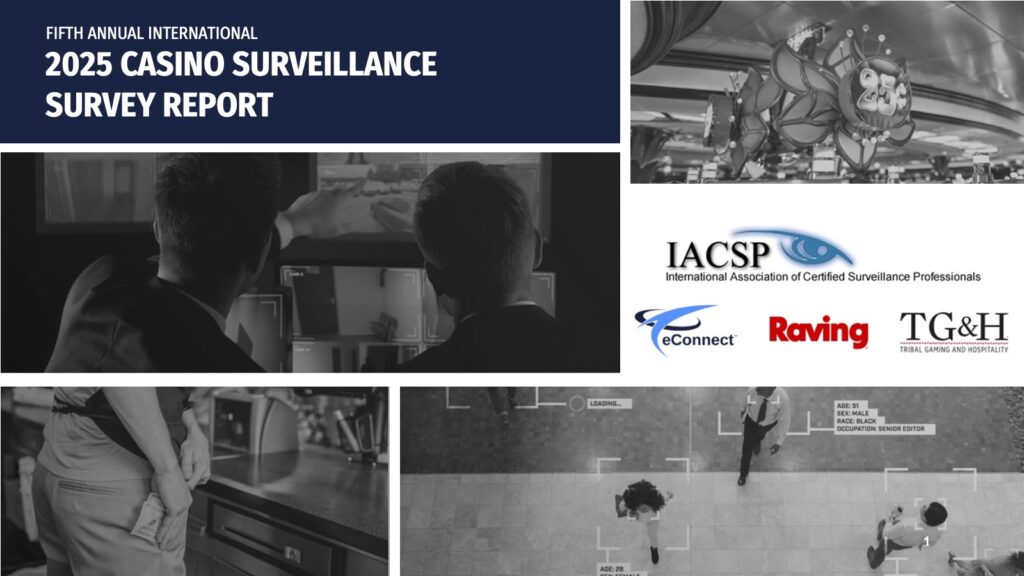Casinos have always lived at the intersection of entertainment, risk, and vigilance. The casino floor is not only a stage for excitement but also a high-stakes battleground where billions of dollars exchange hands — and with it comes opportunity for theft, fraud, and deception. Surveillance teams are the quiet guardians of this ecosystem, blending sharp human observation with advanced technologies to protect assets, guests, and the integrity of the games.
The 2025 International Casino Surveillance Survey shines a spotlight on how the industry is evolving. It captures both the growing sophistication of threats and the strategic responses of surveillance departments. The findings tell a story of transition: from reactive monitoring to proactive, analytics-driven security.
Here’s what to know:
Operating trends: From watching to anticipating
For decades, casino surveillance has revolved around table games, and with good reason. Table games carry high volatility, sensitivity to manipulation, and can trigger major revenue swings within a single shift. Unsurprisingly, table games remain the primary surveillance focus in 2025.
Yet the landscape is shifting. Other risk domains are increasingly demanding attention:
- Guest-related incidents, from disputes to physical altercations.
- AML compliance, ensuring operations align with strict financial regulations.
- Internal theft and fraud are perennial threats from trusted insiders.
- Human trafficking concerns, reflecting broader societal responsibilities, are something that casinos cannot ignore.
Meanwhile, the emergence of electronic table games (ETGs) is altering the balance of priorities. These hybrids—part machine, part traditional table—require surveillance teams to extend their oversight into areas once dominated by slot departments.
Operationally, the survey shows live patrols and video review still consume the lion’s share of surveillance resources. However, a measurable shift is underway toward information analysis, signaling a transformation from purely reactive monitoring to proactive threat anticipation. Forward-thinking teams are already using data analytics not just to spot incidents, but to optimize staffing, predict risks, and streamline investigations.
The Threat Matrix: Internal risks and digital danger
The survey confirms what many in the industry have long known: internal theft and fraud remain the most pressing threats. Insiders have both access and knowledge, allowing them to inflict high-value losses that ripple across operations.
Close behind is cheating, the timeless adversary of casinos. Though the tactics evolve, from sleight-of-hand to collusion, the threat remains ever-present.
However, 2025 underscores a sobering reality: cyber threats are now on par with traditional cheating. While slightly down from 2024 levels, losses from ransomware, phishing, and other cyberattacks rival those from cheating. Surveillance departments can no longer limit themselves to the physical casino floor; they must integrate cyber-physical threat management, encompassing digital vulnerabilities, recovery strategies, and resilience planning.
Emerging risks also loom large. Slot advantage play and vulnerabilities in electronic table games are gaining visibility, adding yet another layer of complexity to the threat matrix.
Detection shifts: From the pit to the audit room
Perhaps the most revealing trend in the survey is how detection methods have changed over the past four years.
In 2021, live detection—spotting a scam as it happened—was the crown jewel of surveillance. By 2025, surveillance investigation and audits dominate detection methods, particularly for:
- Cheating incidents
- Advantage play
- Internal theft and fraud
The statistics tell the story: cheating detections from investigations/audits rose from 57% in 2021 to 71% in 2025. This seismic shift reflects the reality of modern deception.
Why? Because the tools of the trade have changed. Offenders use miniature cameras, cell phones, and terminal manipulations that appear completely normal in real time. A cashier inputting fraudulent data at a player’s club terminal, for example, may look like any other transaction. The deception only becomes apparent when consistent losses trigger an investigation or when an audit of key transactions uncovers irregularities.
Surveillance departments are responding wisely. They are redirecting resources from constant real-time observation to deeper investigative work, recognizing that the scams of 2025 often unfold invisibly in plain sight.
Technology: Friend and foe
Technology empowers both sides of this contest. Surveillance professionals use analytics platforms, AI-enabled video review, and data visualization tools to find patterns invisible to the naked eye.
But the “bad guys” are adapting just as fast. They exploit consumer tech—phones, wearables, hidden cameras—to cheat or steal without raising immediate suspicion. This arms race highlights why audits and investigative techniques are now critical. Simply watching is no longer enough; teams must connect the dots across multiple systems and timeframes.
What a world-class surveillance room would do
The findings raise an important question: What separates an average surveillance department from a world-class one?
A truly world-class surveillance room in 2025 would operate on four key pillars:
-
Integrated monitoring and cybersecurity
The days of treating physical and digital threats separately are over. A top-tier surveillance room would maintain seamless coordination between surveillance and IT security teams, creating a cyber-physical fusion center. Threat intelligence feeds, ransomware simulations, and cyber incident response plans would sit alongside floor monitoring dashboards.
-
Data-driven investigations
Rather than relying on sheer hours of video review, world-class teams would prioritize pattern recognition and anomaly detection. AI-assisted analytics could flag irregular betting patterns, suspicious cash handling, or unusual slot activity. Every flagged anomaly would feed into a continuous improvement cycle, strengthening future detection.
-
Cross-functional collaboration
Surveillance cannot exist in isolation. A leading room would coordinate with compliance officers, HR, operations, and law enforcement. Information-sharing agreements, cross-training, and joint task forces would ensure threats are addressed holistically, not in silos.
-
Culture of proactivity
Finally, excellence means shifting from “catching wrongdoers” to anticipating risks. This includes:
- Regular audits of transaction data.
- Proactive monitoring of emerging scams across the industry.
- Training staff to recognize subtle cues of insider fraud.
- Investing in staff development so surveillance officers think like investigators, not just monitors.
The surveillance room of the future will resemble a mission control center, blending live feeds, data streams, and investigative tools into a hub that sees beyond the immediate and prepares for the inevitable.
The road ahead
The 2025 survey makes one lesson abundantly clear: the battlefield of casino surveillance is expanding. The threats are no longer confined to the blackjack table or roulette wheel—they extend into cyberspace, human resources, and the broader regulatory environment.
Casinos that cling to outdated surveillance models—endlessly watching video feeds while ignoring data analytics—risk falling behind adversaries who are increasingly tech-savvy.
The winners will be those who embrace a proactive, analytics-first model. By investing in audits, integrating cyber defenses, and fostering a culture of collaboration, surveillance teams can stay one step ahead.
As one veteran surveillance director put it, “Technology helps us, but it also helps the people we’re chasing. The only way to win is to think two moves ahead.”
In an industry built on chance, surveillance cannot afford to gamble. The house may always win at the tables, but in the surveillance room, victory belongs to those who anticipate—not just observe.
The 2025 International Casino Surveillance Survey has been sponsored by IACSP, Raving, eConnect, and Tribal Gaming & Hospitality Magazine for the last five years.
To find out more about Raving’s Security and Surveillance programs, please visit: https://betravingknows.com/services/security-surveillance/
To request a free copy of the 2025 International Casino Surveillance Survey or to watch the post-survey webinar, please visit here.




